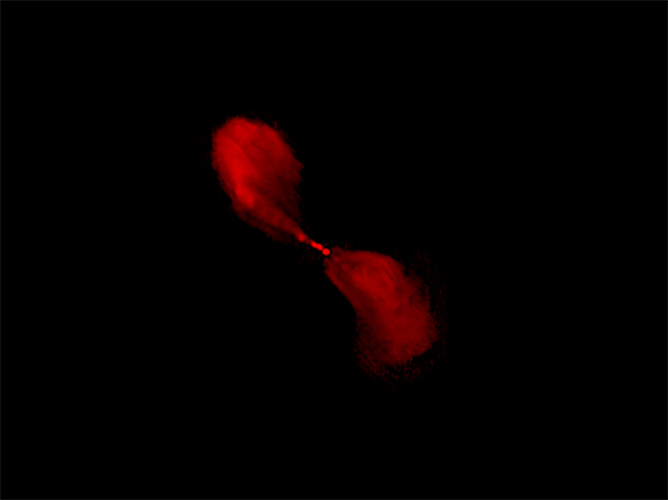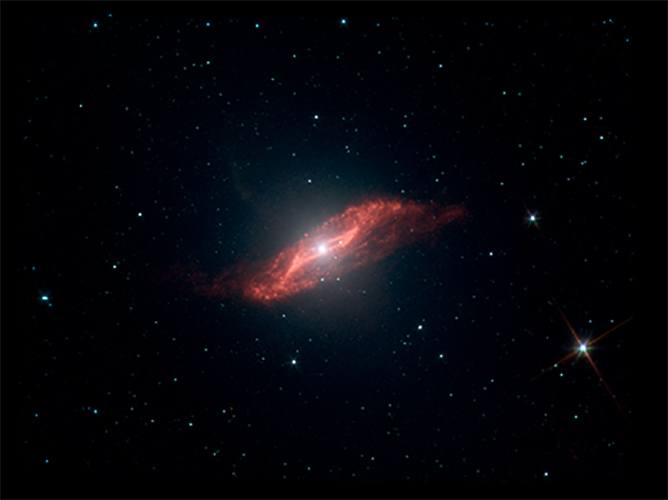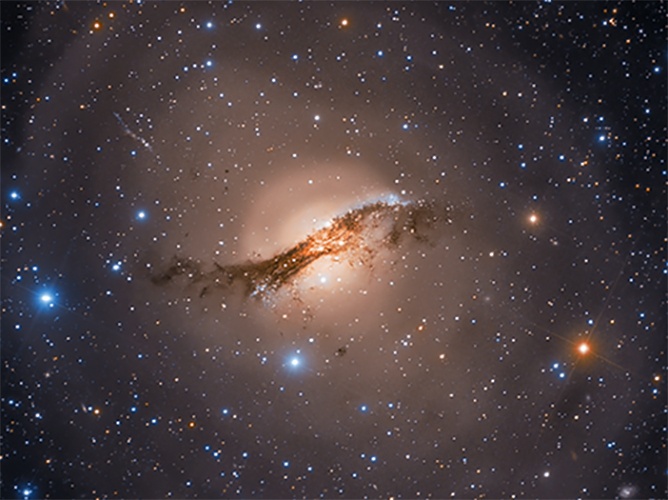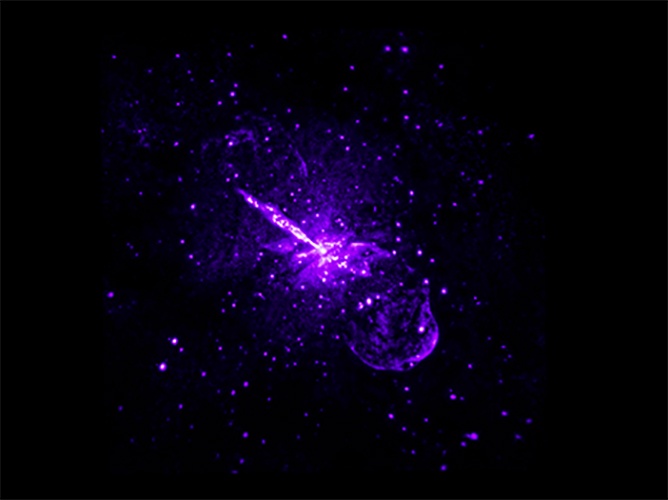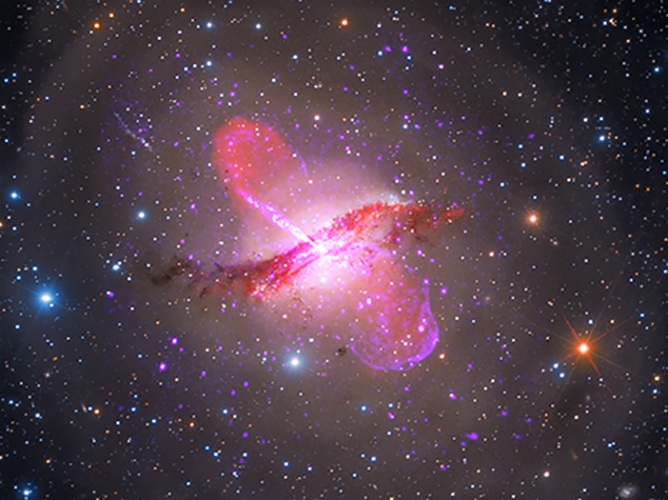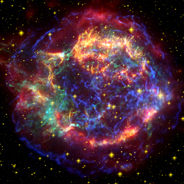Interactive Overview
Slider Interactive: A series of images showing elliptical galaxy Centaurus A’s supermassive black hole in different wavelengths of light. Below the caption is a horizontal slider bar with five labeled stops and a solid white circle. Dragging the white circle right and left along the slider bar causes the image, labels, and caption to change. The change occurs gradually as one image, along with its associated captions and labels, fades out and the next fades in. A toggle button to the upper right of the image turns the image labels off and on. Labels are in the form of text with arrows pointing to specific features in the image. Other labels are graphic overlays.
Slider Stops
From left to right, the slider stops are labeled: Radio, Infrared, Visible, X-ray, and Multi-wavelength.
Summary of Slider Stops
Sliding left to right reveals the following:
- “Radio” stop shows the black hole’s location and its jets as blotches of red. This is the initial image shown when the interactive is loaded.
- “Infrared” stop shows the black hole’s location and dull red-orange gas surrounding it among a field of stars.
- “Visible” stop shows dark brown wisps of dust that surround and block the black hole’s location, as well as ring-like bands of light that become more transparent moving toward the image’s edges.
- “X-ray” stop shows the black hole’s location, its jets, and bulbous pockets of gas among specks of purple.
- “Multi-wavelength” stop shows a composite of all the interactive’s wavelengths combined.
Stop 1: Radio
Image Description: Radio
Image of Centaurus A as seen in radio light. Against a black background, a somewhat symmetrical red object lies diagonal, from top left to bottom right, in the center. A thin, bright red line and dot in the center connects two red bulbous plumes that are wispy in texture.
Labels: Radio
There are three text labels. The small, red dot roughly at center is labeled “Black hole.” The wispy red plume toward the top left is labeled “Jet pointing toward Earth,” while the plume toward the bottom right is labeled “Jet pointing away from Earth.”
Caption: Radio
Centaurus A’s central, active supermassive black hole launches opposing jets that stretch 40,000 light-years from end to end.
Stop 2: Infrared
Image Description: Infrared
This image reveals the same view of Centaurus A, now seen in infrared light. A small, bright white circle is in the center of the image and is surrounded by fluffy, dull red-orange material. The material is diagonally oriented so that it stretches from slightly lower left to slightly upper right, at the opposite angle the radio image appears in. It is also only about half the length as the object in the “Radio” stop. In the red-orange material is a diamond-shaped structure. A faint haze forms a small circle around the white circular core and the elliptical-shaped red-orange material. Stars seen as small points of light, some with diffraction spikes, are scattered thinly across.
Labels: Infrared
There are two text labels. The bright white circular center is labeled “Black hole.” The surrounding fluffy, dull red-orange material around the center is labeled “Glowing, cold dust.”
Caption: Infrared
Infrared light highlights the bright area around the supermassive black hole and colder dust where stars are forming.
Stop 3: Visible
Image Description: Visible
This image reveals the same view of Centaurus A, now seen in visible light. In the center is a wavy line of dark brown filaments of material, covering most of the area and in the same orientation as the fluffy red-orange material in the prior “Infrared” stop. This brown material also extends slightly off to the left. Hazy light brown light is emitted from the center in concentric rings, each ring becoming more transparent moving away from the center. Stars, seen as bright points of light in various sizes—some with diffraction spikes and halos—are densely scattered across this swath of space in various colors: white, blue-white, yellow, and orange.
Labels: Visible
There is one text label. The filaments of dark brown material that surround and block the black hole is labeled “Dust-filled central region.”
Caption: Visible
The wavy dust band in Centaurus A indicates two galaxies are merging, but the dust blocks the black hole in visible light.
Stop 4: X-ray
Image Description: X-ray
This image reveals the same view of Centaurus A, now seen in X-ray light. In the center of the image is a bright purple splotch, with a distinct purple line extending from the center toward the top left, and a half circle shaped bulb extending away from the center toward the bottom right, in a similar orientation to the view in the “Radio” stop. Small purple points are scattered across the full view.
Labels: X-ray
There are three text labels. A bright point in the center of the dense splotchy area is labeled “Black hole.” The thin purple line toward the top left is labeled “Jet pointed toward Earth.” The half-circle purple area toward the bottom right is labeled “Shock-heated gas.”
Caption: X-ray
In X-ray light, we can spot one narrow jet and see another that ends in a semi-circular shockwave.
Stop 5: Multi-wavelength
Image Description: Multi-wavelength
This image is a composite of the wavelengths explored in the previous stops. The center is the brightest part of the image. A thin, wavy line of dark red material, which is a combination of the features seen in the “Infrared” and “Visible” stops, stretches diagonally across the center and extends from slightly lower left to slightly upper right. The purple and red bulbous plumes and lines that were seen in the “Radio” and “X-ray” stops are perpendicular to the dark red material and expand outward from the center toward the top left and bottom right. Hazy light brown concentric rings of light extend from the center, each ring becoming more transparent toward the image’s edges. Bright points of light in various sizes—some with diffraction spikes and halos—are densely scattered across this swath of space in various colors: purple, white, blue-white, yellow, and orange.
Labels: Multi-wavelength
There are three text labels. The dark red filaments of material are labeled “Active star formation.” The red and purple bulbous areas toward the top left and bottom right are both labeled “Jet.”
Caption: Multi-wavelength
By compiling many types of light into one image, we can see the galaxy, and the black hole and its jets.
